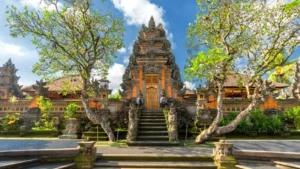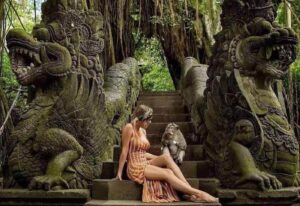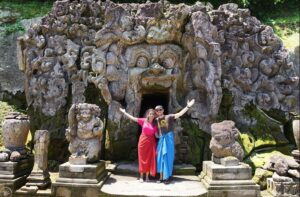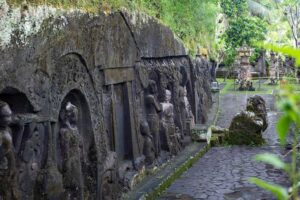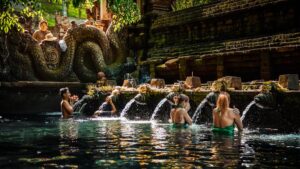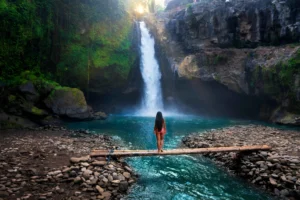7 Most Iconic Ubud Landmarks You Must Visit
When people think about Bali, Ubud often comes to mind as the cultural and spiritual heart of the island. This charming town is filled with history, sacred temples, lush rice terraces, and artistic treasures that have captivated travelers for decades. Exploring Ubud landmarks is a journey into the essence of Balinese tradition, spirituality, and natural beauty.
If you are planning to visit Ubud, make sure these seven iconic landmarks are on your list. Each site offers a unique glimpse into Bali’s heritage and landscape, making your trip both enriching and unforgettable.
Why You Must Visit Ubud Landmarks?
Visiting Ubud landmarks is more than just sightseeing—it’s about experiencing the soul of Bali. Each landmark reflects a different aspect of the island’s identity, from spirituality and history to art and nature.
Cultural Immersion: Temples like Tirta Empul and Goa Gajah connect you with Bali’s ancient traditions and rituals.
Natural Beauty: Rice terraces and waterfalls showcase landscapes that are both breathtaking and iconic.
Spiritual Connection: Many landmarks are sacred, offering a chance to experience Bali’s deep spirituality firsthand.
Unique Experiences: From exploring palaces to walking through monkey forests, every site provides a memory you can’t find anywhere else.
These reasons make Ubud landmarks essential stops for travelers who want to understand Bali on a deeper level—not just as a holiday spot, but as a living culture.
Most Iconic Ubud Landmarks
1. Ubud Palace (Puri Saren Agung)
Image Source: www.forevervacation.com
The Ubud Palace, or Puri Saren Agung, is one of the most central and important Ubud landmarks. Built during the 16th century, it was once the residence of Ubud’s royal family and remains a cultural hub today.
Here, you’ll find ornate Balinese architecture, beautiful gardens, and traditional statues that reflect the island’s artistry. In the evening, the palace becomes even more magical as traditional dance performances take place against the backdrop of ancient stone carvings.
Historical Story
The palace was constructed during the reign of Ida Tjokorda Putu Kandel (1800–1823) and has since been the center of Ubud’s royal lineage. Despite natural disasters such as the 1917 earthquake, the palace has been carefully restored and continues to represent the power and influence of Ubud’s royal family. Today, it serves as both a residence and a venue for cultural preservation.
Location
Ubud Palace is located right in the heart of Ubud, on Jalan Raya Ubud No. 8, directly across from the Ubud Art Market. Its central location makes it easily accessible on foot, and it’s often the starting point for many visitors exploring the town.
Highlight
Traditional Dance Shows: Nightly performances of Legong and Barong dance.
Balinese Architecture: Ornate carvings and traditional courtyards.
Cultural Hub: A living symbol of Ubud’s royal heritage.
Tip: Arrive before sunset to capture stunning photos, and don’t miss the chance to watch a Legong dance performance.
2. Sacred Monkey Forest Sanctuary
Image Source: www.forevervacation.com
The Sacred Monkey Forest is not only a popular attraction but also a spiritual and ecological landmark. This lush jungle sanctuary is home to over 1,200 Balinese long-tailed macaques, living freely among ancient temples and towering banyan trees.
Historical Story
The forest has been considered sacred for centuries and is home to three temples dating back to the 14th century: Pura Dalem Agung Padangtegal, Pura Beji, and Pura Prajapati. These temples remain active sites for local ceremonies.
Location
Situated at the southern end of Jalan Monkey Forest, just a short walk from Ubud’s main center.
Highlight
Ancient temples hidden in the forest
Natural sanctuary with monkeys and lush greenery
Combination of cultural, spiritual, and ecological values
Tip: Keep your belongings safe, as the monkeys are curious and sometimes mischievous.
3. Goa Gajah (Elephant Cave)
Image Source: www.befreetour.com
Goa Gajah, or Elephant Cave, is one of Ubud’s most mysterious archaeological sites. Its menacing stone-carved entrance leads into a cave used for meditation and spiritual practices.
Historical Story
Dating back to the 9th century, Goa Gajah was believed to be a sanctuary for monks. The site combines Hindu and Buddhist influences, making it a fascinating reflection of Bali’s diverse religious history.
Location
About 6 km southeast of central Ubud, on Jalan Goa Gajah.
Highlight
Intricate cave entrance with mythological carvings
Meditation cave and ancient bathing pools
Blend of Hindu and Buddhist elements
Tip: Wear comfortable shoes as there are stone steps and paths to navigate.
4. Pura Yeh Pulu
Image Source: www.nowbali.co.id
Pura Yeh Pulu is a hidden gem among Ubud landmarks, offering a quiet escape into Bali’s ancient past. Its stone reliefs stretch along a cliff face, depicting scenes of village life centuries ago.
Historical Story
Discovered in 1925, the carvings are thought to date back to the 14th or 15th century. Unlike other temples, Yeh Pulu showcases everyday activities like farming, hunting, and feasting—giving a rare glimpse into Bali’s early life.
Location
Located in the village of Bedulu, just east of Ubud.
Highlight
Long stone reliefs with ancient village scenes
Peaceful atmosphere, away from the crowds
Spiritual significance for local Balinese communities
Tip: Visit in the morning for a quiet, reflective experience.
5. Tirta Empul Temple
Image Source: www.outoftownblog.com
Tirta Empul is one of Bali’s most sacred temples, known for its holy spring water where purification rituals take place. Visitors can participate in the ritual by bathing in the pools to cleanse body and spirit.
Historical Story
Built in 962 AD during the Warmadewa dynasty, the temple was dedicated to Vishnu, the Hindu god of water. Its sacred spring is believed to have been created by the god Indra to defeat a demon.
Location
Situated in Tampaksiring Village, about 30 minutes northeast of Ubud.
Highlight
Holy spring pools for purification rituals
Active place of worship with strong spiritual energy
Historic temple architecture and sacred atmosphere
Tip: Sarongs are required to enter, and they can be borrowed at the entrance.
6. Tegalalang Rice Terrace
Image Source: www.jaredsdetours.com
Tegallalang Rice Terrace is one of the most photographed Ubud landmarks, showcasing the beauty of Bali’s terraced rice fields. Its sweeping views and cultural significance make it a must-visit.
Historical Story
The rice terraces are built using the ancient subak irrigation system, a traditional Balinese cooperative method that dates back to the 8th century. This system reflects the harmony between humans, nature, and the gods.
Location
Located in Tegalalang Village, about 9 km north of Ubud.
Highlight
Stunning rice terraces cascading down the hills
Opportunity for trekking and photography
Famous Bali swings overlooking the valley
Tip: Visit early morning for fewer crowds and softer lighting.
7. Tegenungan Waterfall
Image Source: www.thrillophilia.com
If you’re looking for a natural escape near Ubud, Tegenungan Waterfall is the perfect choice. Surrounded by lush jungle, this waterfall offers a refreshing spot for swimming, photography, or simply relaxing to the sound of cascading water.
It’s one of the few waterfalls in Bali that is easily accessible, making it a popular stop for both locals and travelers.
Location
Located in Kemenuh Village, about 10 km south of Ubud.
Highlight
15-meter-high waterfall surrounded by jungle
Natural swimming area at the base
Easy access with stairs leading down to the waterfall
Tip: Best visited in the late afternoon for golden lighting and cooler temperatures.
Tips for Visiting Ubud Landmarks
Dress respectfully when visiting temples (sarong and sash are usually required).
Plan your timing: mornings and late afternoons are best for avoiding crowds and heat.
Stay hydrated and carry light snacks, especially if you’re walking or trekking.
Use local transport such as scooters or hire a driver for convenience.
Combine Ubud Landmarks with Jewelry Workshop
Exploring temples, palaces, rice terraces, and waterfalls is already an unforgettable journey. But why not make your Ubud trip even more special by combining cultural sightseeing with a creative workshop?
At Alam Ubud Jewelry Workshop, you can learn the traditional art of Balinese silver jewelry making. Under the guidance of local artisans, you’ll design and craft your very own piece of jewelry to take home as a unique souvenir.
This hands-on experience is a wonderful way to connect with Bali’s artistic heritage, and it pairs perfectly with a day of exploring Ubud landmarks. Whether you’re traveling as a couple, family, or solo, jewelry classes add a personal and memorable touch to your Bali adventure.
Where to Go
Alam Ubud Jewelry Workshop is located in the heart of Ubud, Bali, just a short distance from famous landmarks like the Ubud Palace and Ubud Art Market. Its central location makes it easy to include in your sightseeing itinerary.
What’s Included
All silver and materials (up to 7 grams of silver included)
Tools and safety equipment
Friendly, professional silversmiths
Your finished piece of silver jewelry to take home
- Optional upgrade like gold plating
Travel Tips
Book in advance to secure your preferred time, especially during peak tourist seasons.
Combine smartly: visit nearby Ubud landmarks in the morning, then relax with a jewelry workshop in the afternoon.
Great for gifts: making jewelry here is not only a fun activity but also a way to craft a meaningful souvenir for yourself or loved ones.
Duration: classes usually take 2–3 hours, perfect to slot into your Ubud itinerary.
Conclusion
Ubud is more than just a destination—it’s the cultural heartbeat of Bali, where history, spirituality, and nature come together. From the royal charm of Ubud Palace to the sacred waters of Tirta Empul and the breathtaking beauty of Tegallalang Rice Terrace, these Ubud landmarks reveal the island’s timeless spirit.
To make your journey even more memorable, balance your exploration with a jewelry-making class at Alam Ubud Jewelry Workshop. Here, you’ll not only discover Bali’s culture but also create a personal keepsake that lasts a lifetime.
Share
Our Workshop Packages
Regular Class
Premium Class
Price:
IDR 250K /pax
- Free Swimming Pool Access
- Full AC Class Room
- Pure 24-Karat Gold
- Silversmith Instructor
- WiFi
Price:
IDR 500K /pax
- Choice of One Drink: Smoothie or Soft Drink
- Free Swimming Pool Access
- Full AC Class Room
- 1-7 Grams Pure Silver for 1 Jewelry Design
- Silversmith Instructor
- WiFi
Price:
IDR 1.900K
- Choice of One Drink: Smoothie or Soft Drink
- Free Swimming Pool Access
- Full AC Class Room
- 1-7 Grams Pure Silver for 1 Jewelry Design
- Silversmith Instructor
- WiFi
Price:
IDR 1.000K
- Choice of One Drink: Smoothie or Soft Drink
- Free Swimming Pool Access
- Full AC Class Room
- 1-7 Grams Pure Silver for 1 Jewelry Design
- Silversmith Instructor
- WiFi
Price:
IDR 500K /pax
- Choice of One Drink: Smoothie or Soft Drink
- Free Swimming Pool Access
- Full AC Class Room
- 1-7 Grams Pure Silver for 1 Jewelry Design
- Silversmith Instructor
- WiFi

